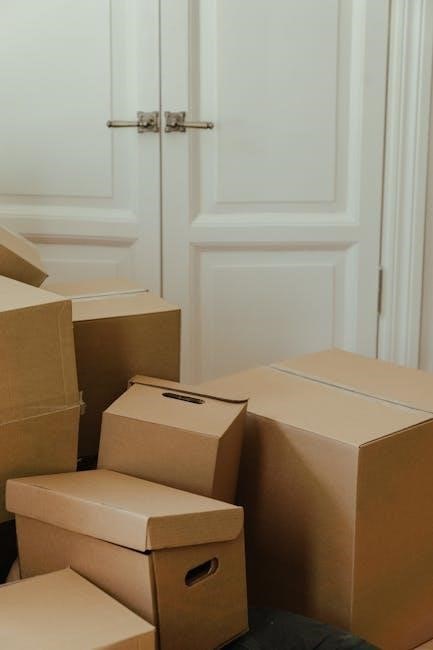Moving to an assisted living facility is a significant life change. A packing checklist ensures a smooth transition, helping seniors and families prepare effectively for their new environment.
1.1 Importance of a Checklist for Smooth Transition
A checklist is essential for a seamless move to assisted living, reducing stress and ensuring organization. It helps prioritize tasks, avoid overlooked items, and streamline the process. By breaking down responsibilities, a checklist makes the transition manageable, allowing seniors and families to focus on adjusting to their new environment with confidence and clarity.
1.2 Key Considerations for Downsizing
Downsizing is crucial when moving to assisted living, as space is often limited. Seniors should focus on essentials, prioritize meaningful items, and consider the facility’s restrictions. Sorting belongings into categories—keep, donate, and discard—helps simplify the process. Understanding the new living space’s layout and storage options ensures a smooth transition and a comfortable, clutter-free environment.
Assessing Space and Facility Requirements
Evaluating the new living space is essential to determine what fits. Consider kitchenettes, pantries, and closet sizes, and adapt packing based on facility-specific rules and limitations.
2.1 Understanding Assisted Living Apartment Layouts
Assisted living apartments often feature compact layouts with limited kitchenettes, microwaves, and small pantries. Closet space varies, typically offering 6 feet of rod and minimal storage. Measure spaces beforehand to plan effectively, ensuring furniture and belongings fit comfortably. Check facility-specific restrictions to avoid overpacking and ensure a smooth transition into the new living environment.
2.2 Facility-Specific Packing Restrictions and Recommendations
Facilities often have specific rules about allowable items, such as kitchen utensils or bedding. Many restrict full-sized appliances due to limited space. Check with the facility for detailed guidelines to avoid overpacking. Label clothing if laundry services are shared, and ensure all items comply with safety and space constraints. This ensures a seamless move and adherence to community standards.
Essential Items to Pack
Pack essential items like clothing, personal care products, bedding, towels, and important documents. Ensure all items are necessary and fit within the facility’s space and guidelines.
3.1 Clothing and Personal Care Essentials
Pack essential clothing items, focusing on comfort and practicality. Include seasonal outfits, undergarments, and footwear. Bring personal care products like toiletries, medications, and grooming tools. Label clothing for easy identification, especially if laundry services are shared. Don’t forget a few cherished items for emotional comfort, ensuring a smooth transition to the new environment.
3.2 Bedding and Towels
Pack essential bedding, including sheets, blankets, and pillows, ensuring they fit the facility’s bed size. Bring a favorite quilt or lap blanket for comfort. Include personal towels, washcloths, and bath towels. Check with the facility for specific bedding requirements, as some may provide linens. Label bedding clearly to avoid mix-ups and ensure a seamless transition to the new living space.
3.3 Personal Documents and Medical Records
Gather and organize essential documents, including medical records, insurance cards, and identification. Pack a copy of the physician referral form, TB test results, and medication lists. Ensure all paperwork is up-to-date and easily accessible for facility staff. Include emergency contacts and a list of healthcare providers to facilitate seamless communication and care coordination.
Personal Touches for a Familiar Environment
Include personal items like photos, artwork, and cherished mementos to create a familiar atmosphere. These touches help seniors feel comfortable and connected to their new space emotionally.
4.1 Decorative Items and Photos
Decorative items and photos personalize the space, making it feel like home. Pack framed pictures, artwork, and small mementos to create a familiar atmosphere. Include favorite blankets or quilts for comfort. Consider upcycling furniture to fit the new space. Ensure items are lightweight and easy to arrange. Check with the facility for specific size or safety restrictions on decorative pieces.
4.2 Comfort Items and Hobbies
Pack comfort items like books, puzzles, or crafting supplies to maintain hobbies and familiarity. Include items that bring joy, such as a favorite blanket or music player. Ensure these items are lightweight and easy to use. Recreate a familiar environment by arranging these items in a way that mimics the previous home, reducing stress and confusion, especially for those with Alzheimer’s or dementia.

Medical and Administrative Preparation
Ensure all medical records, prescriptions, and test results are transferred. Complete required paperwork, including TB tests and physician referrals. Organize financial and legal documents for a seamless transition.
5.1 Required Medical Tests and Evaluations
A TB test and COVID-19 screening are typically required. A physician referral form outlines medical needs, including diagnoses and medications. Facilities also assess care levels for daily living activities, ensuring proper support is provided. Medical records and prescriptions must be transferred to the facility’s preferred pharmacy for continuity of care.
5.2 Paperwork and Financial Arrangements
Complete all required paperwork, including medical forms and financial agreements. Set up utilities like internet and phone, and cancel services at your previous home. Update your address with USPS and relevant contacts. Ensure bills and payments are transferred smoothly to avoid disruptions. Organize financial records and verify insurance coverage for a seamless transition.

Hiring Professional Assistance
Consider hiring senior move managers or professional movers to ease the transition. They specialize in downsizing, packing, and organizing, ensuring a stress-free relocation experience.
6.1 Senior Move Managers and Their Role
Senior move managers specialize in assisting older adults with relocation. They handle downsizing, packing, and organizing belongings, ensuring a smooth transition to assisted living. These professionals also coordinate logistics, manage moving teams, and set up the new space, making the process less overwhelming for families. Their expertise helps create a comfortable and familiar environment quickly.
6.2 Tips for Hiring Reliable Movers
When hiring movers, research companies thoroughly, check reviews, and request references. Ensure they specialize in senior moves and are experienced with downsizing. Get detailed estimates, compare costs, and verify licensing. Clearly communicate needs, fragile items, and specific instructions to avoid mishaps. A reputable mover will ensure belongings are safely transported and organized in the new space.

Emotional Support and Social Transition
Moving to assisted living can be emotionally challenging. Support from family and friends helps ease the transition, fostering a sense of belonging and reducing feelings of isolation.
7.1 Managing the Emotional Impact of Moving
Moving to assisted living can be emotionally challenging, causing feelings of loss and uncertainty. Involving seniors in decisions and maintaining routines helps ease the transition. Recreating a familiar environment with personal items and staying connected with loved ones can provide comfort and reassurance during this significant life change.
7.2 Engaging with Facility Staff and Community
Building relationships with staff and residents fosters a welcoming environment. Participating in community activities and sharing interests helps create a sense of belonging. Open communication with staff ensures personal needs are met, while social interactions with peers enhance emotional well-being and make the new space feel like home.

Technology and Connectivity
Setting up utilities and internet ensures connectivity. Packing essential devices and organizing communication tools helps maintain relationships and access to important services.
8.1 Setting Up Utilities and Internet
Check with the facility about included utilities and services. Schedule internet and phone installations in advance. Update your address with the USPS and service providers. Label cables and devices for easy setup, ensuring connectivity for communication and entertainment in your new space.
8.2 Ensuring Communication with Loved Ones
Share your new address with family and friends to stay connected. Set up phone, email, and video call options for regular communication. Consider scheduling weekly calls to maintain close relationships. Ensure your device is easy to use and accessible. Inform service providers of your address change to avoid disruptions in communication services.
Finalizing the Move
Confirm moving day details, organize belongings, and double-check the packing checklist. Ensure all items are labeled clearly and ready for transport to the new facility.
9.1 Creating a Moving Day Checklist
A moving day checklist ensures everything is organized and ready. Categorize items by room, label boxes clearly, and pack essentials separately. Confirm the moving schedule with the facility, and have important documents easily accessible. This checklist helps track progress and guarantees a smooth transition to the new assisted living environment.
9.2 Labeling and Organizing Belongings
Clearly label boxes by room and contents for easy unpacking. Use color-coded labels for different areas, like green for the kitchen and blue for the bedroom. Create a master list of items in each box. Organize belongings into categories, such as “Keep,” “Donate,” and “Discard,” to streamline the moving process. Proper labeling ensures a smooth transition and reduces stress during the move.
Post-Move Adjustments
Unpack essentials first to create a comfortable environment. Organize belongings to maximize space and accessibility. Adjust to the new lifestyle, exploring amenities and services available in the facility.
10.1 Unpacking and Organizing the New Space
Start by unpacking essentials like toiletries and clothing. Label storage areas clearly to maintain order. Arrange furniture to create a functional and comfortable layout. Consider using shelves or bins to optimize space, ensuring easy access to frequently used items. Personalize the area with familiar decor to make the new space feel welcoming and home-like, reducing adjustment stress.
10.2 Adjusting to Facility Life and Services
Adjusting to facility life involves embracing new routines and services. Familiarize yourself with staff, amenities, and community activities to build a sense of belonging. Communicate needs and preferences to ensure personalized care. Participate in social events to connect with peers and establish friendships. Allow time to adapt, and seek support from family or counselors if needed to ease the transition smoothly.
Ongoing Support and Resources
Facilities offer access to amenities, services, and programs to enrich daily life. Residents can stay connected with loved ones and engage in community activities. Ongoing support ensures comfort and well-being.
11.1 Accessing Facility Amenities and Services
Residents can access amenities like dining, laundry, and recreational activities. Facilities may offer medical care, therapy sessions, and social programs. Staying organized with provided resources ensures a comfortable and active lifestyle, promoting overall well-being and community engagement.
11.2 Staying Connected with Family and Friends
Maintaining relationships with loved ones is crucial for emotional well-being. Schedule regular calls, video chats, or visits. Facilities often provide internet access, enabling easy communication. Share the new address and contact details to stay connected. Encourage family and friends to participate in activities or events, fostering a sense of belonging and support in the new environment.
A well-organized packing checklist ensures a smooth transition to assisted living, reducing stress and fostering a sense of familiarity. Stay connected with loved ones and embrace this new chapter with confidence and positivity.
12.1 Recap of Key Packing and Transition Strategies
Focus on downsizing and prioritizing essentials like clothing, personal care items, and important documents. Consult the facility for specific guidelines to avoid unnecessary items. Label and organize belongings clearly for easy access. Incorporate personal touches like photos or favorite items to create a familiar environment. Consider hiring professional senior move managers for a stress-free transition and a well-organized space.
12.2 Encouragement for a Positive New Chapter
Embrace this new chapter with confidence and optimism. Assisted living offers a supportive community, tailored services, and opportunities for social engagement. By staying organized and informed, you can navigate this transition smoothly. Remember, this change is a step toward a comfortable and fulfilling lifestyle, surrounded by care and understanding.
